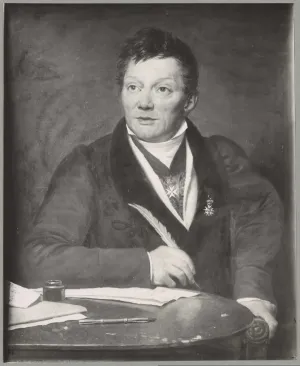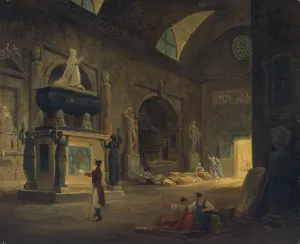Ars Longa: Capturing a Revolutionary Restoration
August 17, 2021
By Sarah Bigler, Photoarchivist
This seemingly unremarkable photograph of a statue of King Louis XII of France (1462–1515) conceals the sculpture’s turbulent five-hundred-year history. The reproduction from the collection of the Frick Art Reference Library’s Photoarchive shows the king standing tall, leaning against a column and giving a gesture of blessing. The stance and attire are reminiscent of ancient Greek and Roman sculpture, the narrative reliefs on the intricate breastplate resembling the famed Augustus of Primaporta. However, if you visit the Musée du Louvre in Paris and look for this statue today, you might be surprised to find it is now in three pieces: torso, head, and legs.
The Photoarchive image above depicts the statue in the galleries at the Louvre as it likely looked in the first two decades of the twentieth century, before its subsequent disassembly. The photograph comes from the Archives Photographiques des Beaux-Arts in Paris and was probably acquired for the Photoarchive in the 1920s by Clotilde Brière-Misme, the library’s agent in France.
The original sculpture by sixteenth-century Italian artist Lorenzo da Mugiano was completed around 1508 and brought to France in February 1509 from Milan—during Louis XII’s conquest in Italy—by the Archbishop of Rouen, Georges d’Amboise (1460–1510). It was housed in the bishop’s Château de Gaillon in Normandy, where it remained for about two hundred years, until the French Revolution erupted in 1789.
In the early phases of the Revolution, works of art and architecture from all over France were looted, damaged, and destroyed in an attempt to wipe the slate clean of centuries of monarchy, rigid social hierarchy, and oppression. Religious art and architecture were major targets. Before actual enemies of the Revolution were beheaded, carved faces or entire figures were chiseled off of medieval cathedrals, and churches themselves were burned. Art with subjects pertaining to the ancien régime also came under fire. Entire collections once owned by the nobility and the clergy, like at the Château de Gaillon, were confiscated by the republican state. The sculpture of Louis XII seems to have been vandalized in 1793, when archeologist Alexandre Lenoir (1761–1839) records that the head and right hand had been removed.
The remains of the sculpture were subsequently brought to Paris to be displayed in Lenoir’s Musée des Monuments Français, between 1796–98. The museum’s collection was composed of sculpture taken from the collections of religious institutions, churches, and private owners. It ultimately became a vast repository documenting the history of French sculpture, growing to house thousands of items by the time it closed in 1816.
Sometime between 1798 and 1800, while in the collection of the Musée des Monuments Français, the sculpture’s head and hands—removed during the Revolutionary iconoclasm—were reconstructed by sculptor Pierre-Nicolas Beauvallet (1750–1818). The face was likely modeled on the portrait of the king from his tomb in the Basilica of Saint-Denis. The restored sculpture of Louis XII remained in the Musée des Monuments Français until its closure, when it was transferred to the Louvre, which opened as a public museum in 1793.
In 1834, the sculpture underwent another restoration, which resulted in the condition captured in the library’s photograph of the work. This time it was transformed into a full-length statue by the artist Bernard Lange (1754–1839), after which it was moved for a period into the galleries at Versailles. Finally, in 1850, Louis XII was returned to the Louvre, where it remains today. The Photoarchive’s image of the statue documents this iteration more than fifty years after its transfer back to Paris, where we see it standing pieced back together after two phases of reconstruction.
Today, Louis XII is exhibited and catalogued by the Louvre as three separate works: the sixteenth-century torso by Mugiano, the eighteenth-century head by Beauvallet, and the nineteenth-century legs and base by Lange. The disassembly of the sculpture in the twentieth century, like its earlier reconstruction, was done in stages: The legs were removed first in 1934, and finally the head was detached in 1960.
The photograph of the assembled statue held in the Photoarchive captures a specific moment in time, allowing us to understand—and, more importantly, to visualize—the history of this object, which was imported, destroyed, restored, and subsequently dismembered, at each stage physically marked by the dramatically shifting political landscape and cultural values in France. The Photoarchive documents for posterity the brief but significant period in the lifetime of this sculpture, between 1834 and 1934, when Louis XII was once again whole.
The Photoarchive is the founding collection of the Frick Art Reference Library, comprising reproductions of more than one million works of art. Ars Longa is a blog series exploring the documentation of lost, altered, and destroyed works—as well as those in private collections or otherwise not easily accessible—highlighting the Photoarchive as an invaluable resource for the public.
Sources
Greene, Christopher M. “Alexandre Lenoir and the Musée des Monuments Français during the French Revolution.” French Historical Studies 12, no. 2 (1981): 200–22. Accessed August 12, 2021.
Musée du Louvre, website. Accessed August 2021.






